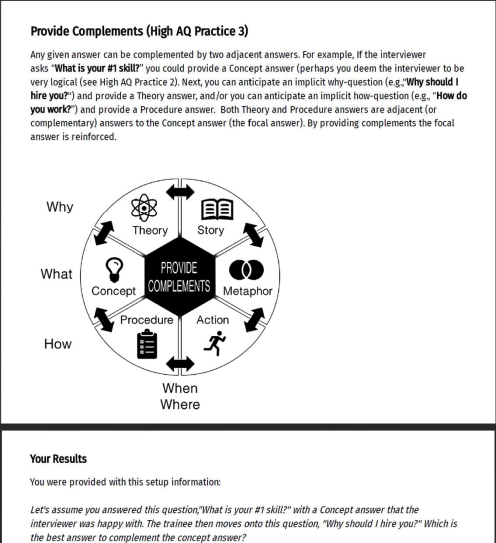For the people that don’t know you yet: Who is Brian Glibkowski?
Our goal is that we want to be the number one communication platform and assessment tool in the world. Pointerpro is a big part of that.

With my background in both business and academia, I’ve been doing research on questions and more recently started focusing on answers. Unexplored territory in the academic world!
I’ve written a book and gone to market with a suite of assessments and tools, targeting professional service firms around the world: coaches, trainers, and consultants. We have certified partners in over 10 countries now.
We started Raise your AQ, a project based on AQ or answer intelligence, a framework that we use to come up with the right answers to important questions. A taxonomy of answers, if you may.
Our goal is that we want to be the number one communication platform and assessment tool in the world. Pointerpro is a big part of that.
How does Answer Intelligence (AQ) work exactly?
 In general, the idea is to implement the new science of answers to elevate conversations.
In general, the idea is to implement the new science of answers to elevate conversations.
We are taking a small first step towards restoring the balance between questions and answers. AQ’s focus lies on answers but no science of answers can exist without an examination of questions.
Questions can be asked to benefit both others and ourselves but answers are unambiguous. We created a framework to lead you to a higher AQ, or way of elevating your answers when the questions are the most important and the answers matter the most.
In our model we differentiate between the left and the right side of the brain. The left side is logical, objective and sequential. It prefers answers based on theory, concept and procedure. The right side, on the other hand, is creative, subjective and random. It prefers answers such as story, metaphor and action.
Could you give us an example of this?
Well, a great communicator uses both sides of the brain simultaneously so this has to be the thing we aspire to achieve. By using automated Pointerpro reports, like the one below we can immediately provide prospects with personalized advice. This advice covers communication through both sides of the brain.

Could you tell us more about how Pointerpro fits into this story?
Pointerpro is an integral part of what I’m doing. We have a whole continuum of solutions and many of these relate to Pointerpro.
So if you think about important conversations, whether it’s in sales or in interviews, it’s always about the answers. They are often the most important, you know, to get a job or to close the deal in sales, you need to have effective answers. You have to answer the question, the proverbial question that keeps the executive up at night.
That’s the framework. It applies to coaching, training, workshops and consulting.
We started our Explore AQ, a lead generation tool that we provide to partners and that can be customized in Pointerpro to any topic, using piping logic *.
You’ll see changes in e.g. the question types and someone would simply indicate which answer type they would use and would then get a score.
These are Pointerpro PDF reports zero to a hundred percent. And this has been a really great tool for us because it’s completely at the right level.
**Editor’s note: This logic allows them to insert answers to previous questions into upcoming questions or titles. Let’s say you answered that blue is your favorite color in question A, then we could make question B into “What’s your favorite blue object?” for example. It immediately makes for custom-made assessments.

When you say “at the right level”, you mean for your clients?
It has to be valuable. It has to be interesting. And you know, they need to want more. I think sometimes lead gen tools can be superficial, which can be okay, but I think they have to be substantive.
So this has really generated a lot of interest for our partners. Several deals are attributable to this part of the sales funnel. And this also can be repurposed in other ways, such as with workshops. So on the enterprise level, for example, I just did a workshop for a pharmaceutical company for 175 sales reps.
They were all asked to fill out this Explorer AQ before the keynote, and then transitioned to workshops and I’m doing those.
So what makes us different then?
I personally think that where the market is right now, surveys and assessments are crucially important.
I think that for Pointerpro it’s all about the user experience. Think of the interface where you can interleave little videos or scores into the survey or assessment.
I haven’t done that yet, but I think that’s really a great feature. After the full report, there’s a tool outside of Pointerpro, a platform to basically input questions, where you can immediately provide answers. And there’s a timestamp feedback area for different answers and even a rubric.
This is great. If you have a group of 20 people, you can go through each response really quickly and show positive and negative responses in a training. I haven’t launched this for general release, but have been testing it and I think there’s a lot of potential for this.
As a side note, I personally think that where the market is right now, surveys and assessments are crucially important.
How did you end up with Pointerpro? Did you work with other tools before?
You know, I worked with other tools in the past. As I’m still in academia, the tools were different but I’ll be focusing on this full time in a couple months.
If a company had a turnover problem, I would develop a survey to understand what the problems were. I typically used Survey Monkey. They’re all pretty much the same from the question standpoint anyway. But then I started struggling with reports.
At that point, I would develop elaborate PowerPoints, Word documents and even designed dashboards – I went through all these different phases. At the end of the day, I think that’s when I realized that people don’t really want to explore the data.
They nonetheless want the complex solutions and I started looking for other existing providers in the marketplace for similar assessments.
When I started looking at these tools, I found that the standard practice was PDF reports.
This really dissuaded me from doing other things like dashboards, because a lot of different platforms like power BI and others didn’t really matter anymore because people still like reports.
When it comes to the marketplace that we’re primarily targeting right now, which are executive coaches, they just want PDF reports. Nobody has ever asked: “Do you have a dashboard for all this?” Like, not once. So that’s when I started looking for platforms that I can customize and sort of meet my requirements, which I wasn’t sure exactly what they were at the time.
Then, through searching, I came across Pointerpro. I found a couple of other vendors in the market, but I think by far you had the best feature set.
One last question: any tips or lessons you could share?
I really like the idea of starting from the report and then building down, to start with.
Moreover and in no particular order, it’s very intuitive and you know what the report will look like without completing everything in detail. “Here’s a text box and it’s going to explain the graph on the left”. The more you can implement things like that, the better.
Shorter reports are better than longer reports, that’s another thing I found in the marketplace with these other assessment providers that I was talking to. There seems to be a trend towards shorter reports, which I think makes sense, since people have short attention spans.
It’s very intuitive and you know what the report will look like without completing everything in detail


